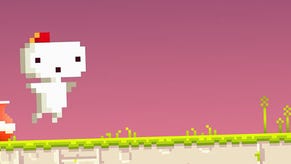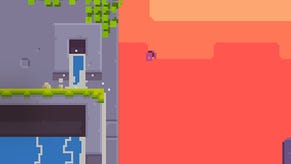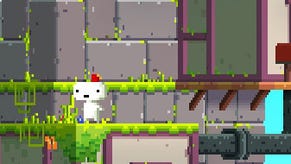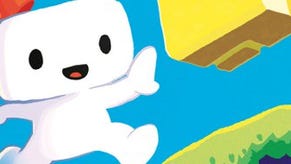Fez PlayStation Vita Review: Born to Run
This bizarre world of black holes, divine owls, and spinning tesseracts feels like it was always meant to be portable.
This article first appeared on USgamer, a partner publication of VG247. Some content, such as this article, has been migrated to VG247 for posterity after USgamer's closure - but it has not been edited or further vetted by the VG247 team.
One of all-time favorite film visual effects shots appears in Jim Henson's 1986 Labyrinth. Somewhere in the middle of the movie, one of the characters wanders past a massive rock bust of the villain, Jareth (played by the ubiquitous David Bowie), then strides through it. As the camera tracks across the shot, the changing perspective reveals that the bust consists of three separate pieces placed in a line, visible as a sculpture to the audience but merely disconnected stones to those within the scene.
It's a great trick, all the more effective for how utterly basic it is. It reminds the audience of Jareth's seeming omnipresence – a fact doubly reenforced when the camera tracks back and Jareth himself stands between the rocks to taunt his wayward minion – while underscoring the constant watch he keeps over the protagonists' actions. In movie-making terms, there's nothing fancy about the effect; it's just an imaginative bit of set dressing. Yet the disarming simplicity of this trompe-l'oeil effect makes it memorable.
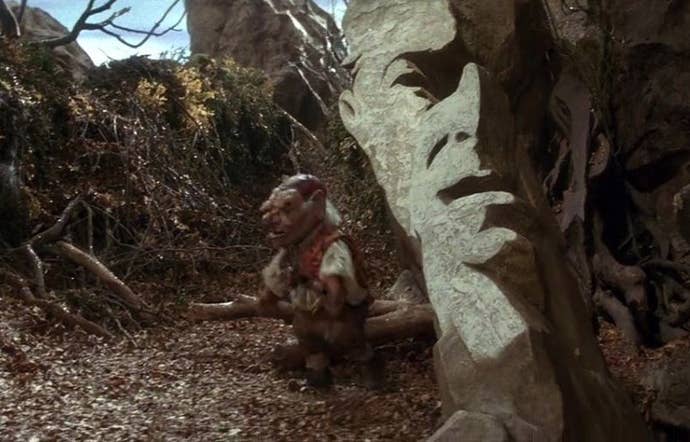
Small wonder, then, that I love Polytron's mysterious platformer adventure game Fez; the entire odyssey revolves quite literally around this sort of false-perspective trick of perception. Its mechanics hinge on the visual compression three-dimensional spaces when viewed on two-dimensional formats, such as computer screens. Fez goes the opposite direction of the rest of the industry, which struggles ever slavishly to create convincing 3D illusions in games. Rather than try and immerse players in its world, it reveals the falsity of its graphics, forcing the player to navigate 3D space by ignoring what they think they know about its constructs and relying strictly on the evidence of their eyes.
Cubes serve as the central motif in Fez, and the entirety of the game sees you navigating the four lateral faces of cubic constructs. At the same time, Fez forces you to work in squares rather than cubes. Depth and distance along the world's Z-axis become a fleeting, ephemeral thing, something you see only briefly as you spin the world from one point of view to another. Once your viewpoint settles, 2D game logic settles in, and every interactive element suddenly exists on a single plane even if only moments before the rotation of the stage revealed them to be far apart. With the mechanics of 2D game graphics and the destruction of proper perspective, the entire world becomes flat when at rest, and distant objects suddenly become adjacent.

Like the rock sculpture of Bowie's face, Fez's world doesn't "work" to anyone except the outside observer. And indeed, the game's limited dialogue plays up this fact, with innocent 2D creatures railing against the evils of "devil squares" – that is, cubes – which exist in dimension beyond their comprehension. Only the player, and by extension his specially empowered avatar Gomez, can see the true depth of Fez's world. And there's danger in Gomez's logic-defying treatment of his environment, as deadly black holes progressively chew apart more and more of the scenery the further you venture into its world and abuse its spaces with your trigger-button tesseracts.
It's fitting, in a way, that in creating a game that reveals the dishonesty inherent in the progressive visual aspirations of the medium, Polytron elected to turn time backward with the game's graphics. While most retro-pixel-art games adopt their style for expedience or just as a gimmick, Fez's regressive look is necessary to allow the mechanics to work. It takes those artful hand-crafted backgrounds of old consoles and arcade games and fleshes them out, asking you to consider what happens when you turn their worlds sideways. Did it make sense for 8-bit heroes to be able to jump up or drop down through platforms? No, and it makes even less sense here. But rather than allow you to dwell on the illogic of its world's structure, Fez instead forces you to embrace it.

As much as I enjoyed Fez when it was first released on Xbox 360 a couple of years ago, I found the game even more enjoyable on PlayStation Vita. The handheld nature of the system complements the puzzle-nature of the game, I think. Spinning Fez's universe and struggling to unravel its cryptic runes on the small screen gives it a feel similar to a Rubik's Cube – almost more a toy than a game. There are no battles to be fought in Fez, no real hazards to overcome. The penalty for falling off a ledge or wandering into a black hole is simply to restart at your last position. The challenge instead comes from unraveling the intricacies of the adventure – from making sense of its dense puzzles, whether spatial or symbolic.
Which of the glyphs that decorate the world are meant as decoration, and which mean something? What's up with the bell, and the telescope, and the owls? Unlike when Fez debuted, you can find the answers to these questions online easily. I recommend you wait, though. Puzzling things out is the entire point of Fez. Why spoil the experience? If you've yet to play the game, this new versions offers a perfect chance to discover it. And if you played it the first time around, now you can revisit it with a guide in hand to help with all the tricky stuff you weren't bright enough to figure out before.
The Breakdown:
- Graphics: Designed in the style of 8-bit classics, but for a reason. Stylish and detailed.
- Audio: Like the graphics, deliberately dated. In this case, though, that's simply for stylistic cohesion.
- Interface: Simple controls work surprisingly well for a complex concept. The map interface (and lack of easy warp travel) continues to be terrible, though.
- Lasting Appeal: A fairly large game, though it's durability is predicated on its riddles and secrets. If you don't cheat, Fez could have you wracking your brain for solutions for ages.
ConclusionA novel exploration of the underpinnings of game graphics, Fez at once pays tribute to classic 2D platformers while revealing the shenanigans that went into their design. Borderline inscrutable at times, Fez is a puzzle on many levels. Yet its mysteries, clever as they are, deserve to be unravelled.

